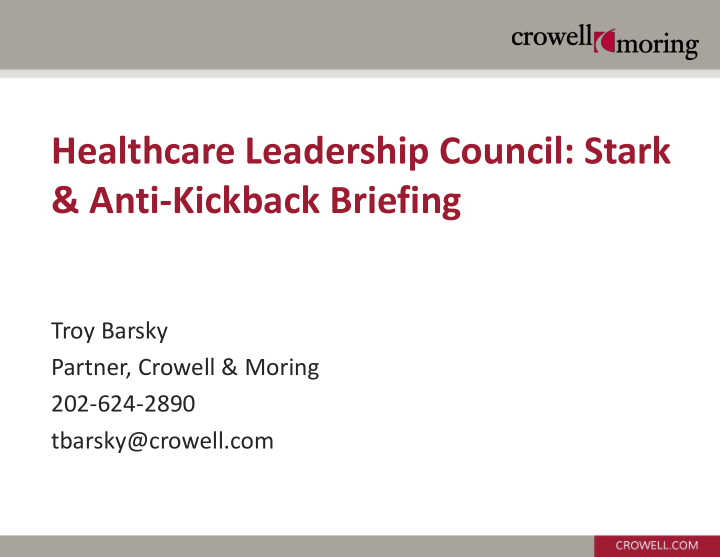



Healthcare Leadership Council: Stark & Anti-Kickback Briefing Troy Barsky Partner, Crowell & Moring 202-624-2890 tbarsky@crowell.com
Agenda • Fraud & Abuse Overview – Physician Self-Referral Law (Stark Law) – Anti-Kickback Statute – Civil Monetary Penalty Law – False Claims Act • Impact on the Medical Technology Industry • Proposal for New Safe Harbor
Stark Law • Physician Self-Referral (Stark) Law prohibits a physician from making a referral to an entity for designated health services payable by Medicare or Medicaid if the physician (or an immediate family member) has a financial relationship with the entity. • “Financial relationship” includes an ownership or investment interest or compensation arrangement. • “Designated Health Services” include, but are not limited to, inpatient and outpatient hospital services, clinical lab services, physical therapy, DME, home health services and outpatient prescription drugs.
Anti-Kickback Statute • The Anti-Kickback Statute (AKS) prohibits providing/offering or soliciting/receiving remuneration (i.e., anything of value) to induce a referral from anyone for federal health care program business • Federal health care programs include Medicaid, Medicare Advantage, and Medicare Part D
Anti-Kickback Statute • "Referral" means referral of a patient or the purchasing, leasing, ordering (or arranging for or recommending purchasing, leasing, or ordering) of any good, facility, service or item if any portion of that patient's care or the cost of the good, facility, service or item may be paid in whole or in part by Medicare, Medicaid, or any other Federal health care program. • The AKS specifically provides that a violation constitutes a false or fraudulent claim under the False Claims Act.
Fraud and Abuse Laws – A Bit of History • Designed for a fee-for-service world • Goal is to combat over-utilization and unnecessary care and to keep parties financially separated • Never designed for the new healthcare economy of integration, population health payments, and value based arrangements. • Federal agencies can make incremental change through regulations, but these laws continue to be a significant barrier to health care innovation
MEDTECH AND THE SHIFT TO VALUE- BASED HEALTHCARE Overarching goal is to share in accountability for improving outcomes at lower cost Long history of collaboration with physicians to improve patient outcomes Clinical trial and healthcare economics expertise can accelerate standardization of patient cohort selection, optimization of care pathway and definition of outcomes Appropriate application of medical technology in healthcare system can help drive inflection points in value creation MedTech companies are expanding role from traditional medical device manufacturers, and are now developers and providers of services and solutions that improve patient outcomes and reduce costs throughout the patient care continuum Use of technology capabilities can address inefficiencies across the bundle, especially in post-acute care Risk-sharing (shared accountability) is central to value-based healthcare models
Challenges to Innovation: VBHC Services and Solutions Existing AKS laws present challenges • AKS laws assume transactions are for the sale of items and • services, not for the sale of clinical or economic outcomes • AKS Warranty Safe Harbor is designed to protect provision of items and services due to a product defect, not a failure to achieve targeted clinical or economic outcomes • AKS Discount Safe Harbor is designed to protect discounts and rebates, not accounting for combined product/service offerings aimed as reducing adverse events and associated costs AKS laws assume traditional reimbursement models rewarding • volume, not value, are in play AKS laws not waived for industry/provider/payer collaborations • under new reimbursement models rewarding value • Limit ability of a non-provider to risk-share around improving health outcomes and lowering costs
Value-Based Arrangement Safe Harbor Protect arrangements implicating Anti-Kickback Statute and Stark Law • Provide opportunities for all stakeholders across the health care • continuum, including providers, payers, and manufacturers Less about who is involved and more about the types of financial and related arrangements to be protected “Entity Agnostic” & “Payer Agnostic” Extend the landscape for such arrangements beyond CMMI pilots and • MACRA APMs Maintain appropriate protections for patients and federal health care • programs
Value-Based Arrangement Safe Harbor New value-based payment safe harbor under the Anti-Kickback Statute – Must be a risk-based or shared savings payment arrangement – Remuneration between entities that further specific quality and cost savings goals can also be protected (e.g., the bundling of an implantable along with consulting and post-discharge patient monitoring services) New value-based payment exception under the Stark Law – Mirrors the terms and conditions of the value-based AKS safe harbor – Allow manufacturers who also become health care providers to enter into value- based arrangements with physicians Safeguards and parameters – Ex. Terms of the arrangement must be set in advance by the parties and include specific quality, cost savings, or health outcomes goals that must be met in order to qualify for payment
Recommend
More recommend